Find out how to create a safe bathroom environment without losing the benefit of tile and other waterproof materials

Using tile or another nonporous surface for bathroom flooring makes sense. You want something that can stand up to water and moisture. The downside is that when those waterproof materials do their job, water accumulates and creates a potential slipping hazard.
With the right design approach, however, you can create a safe bathroom environment. We spoke to several design and remodeling professionals about the best flooring options and other design tips that keep safety in mind. Here’s what they recommend.
Though freestanding tubs are a popular option these days, you might want to consider a built-in design with a substantial deck that enables you to sit and swivel into and out of the tub safely.This Washington, D.C., bathroom by Mid-Atlantic Custom Builders includes a good example of a bathtub deck that offers a user a spot to get situated.
3. Get Grab Bars
Homeowners should consider grab, or assist, bars in diagonal, vertical and horizontal orientations to accommodate various levels of mobility and age.
The grab bars in this Reston, Virginia, bathroom by Synergy Design & Construction provide protection on both sides of the shower without adding a sterile aesthetic. “When someone is falling, the natural reaction is to grab something, but shower doors and tile surfaces are not usually going to help,” Selby says. “Grab bars, shower door bars — inside and out — and other items that help people steady themselves when they become off-balance will help a lot.”
Many manufacturers now make grab bars in more attractive styles than the kind of traditional-looking grab bar you might find in a hospital. Some products hide their function as a towel bar, doing double duty. Designer Kristen Stringer says her go-to is Delta’s 18-inch decorative grab bar, which meets the Americans With Disabilities Act (ADA) guidelines.
4. Follow ADA Guidelines
Speaking of the ADA, when in doubt, look to its guidelines as much as possible. “Following guidelines for an ADA shower or even using aspects of the design elements can increase safety within your bathroom and shower,” designer Katie Pennington says.
For example, roll-in showers that provide wheelchair access, higher toilet seats for easier sitting and standing, wider doorways, smoother floor transitions between rooms and foldable shower seats can all add safety to your bathroom.
Arise Art Group made sure this San Diego bathroom was equipped to support a homeowner with Parkinson’s disease by adding a curbless shower, grab bars, slip-resistant porcelain floors and a wood bench.
5. Bring in a Bench
A bench or other seat in your shower allows you to sit when tired, wash up while seated or rest before exiting the shower, all of which can help prevent slips.
Yamini Designs incorporated a bench in the low-curb shower design of this rustic bathroom in Lake Zurich, Illinois. The bathroom also features other anti-slip examples discussed below, including textured porcelain tile on the main floor and mosaic tile with many grout lines in the shower.
6. Look for Honed and Matte Finishes
When using tile on the floor of a bathroom, go with a honed or matte finish. They provide good grip, unlike a polished surface, and can be applied to almost any clay, ceramic or porcelain tile. That means you can choose almost any color and style of tile and know it will have good grip underfoot.
“Polished tile on the bathroom floor is generally a bad idea,” home builder Alison White says. “If the tile is shiny, chances are it will be slippery when wet.”
The owners of this Burlingame, California, bathroom found design-build firm Building Lab on Houzz to handle their remodel. Bare terra-cotta tile on the shower and main floor offer good footing. The low-curb shower entry and numerous grout lines also help with safe movement.
Even if you’re sure your tile choice is a good fit, always do a test on a sample. “I would test a surface by wetting it, pushing down with my hand and then trying to move my hand laterally,” Meadowlark’s Doug Selby says. “If it moves easily, consider another surface product.”
7. Make It Mosaic Tile With Many Grout Lines
Small tiles and mosaic tiles can be beautiful anti-slip flooring materials for bathrooms, especially in the shower. They involve numerous textured grout lines, which means more grip and better control. “Small tile may create a better sense of grip on the foot since there are more grout lines,” designer Hideaki Kawato says.
For this beach-style bathroom in Long Beach, California, builder White used Fireclay Mini Star & Cross tile for a playful look. Grout lines and raised textures provide extra grip throughout the space.
8. Consider Other Textured Materials
If you’re not keen on ceramic or porcelain tile, you have plenty of other slip-resistant options to consider.
Textured concrete is one stylish example. For the main floor in this industrial bathroom in Phoenix, designer Joel Contreras ground down the concrete flooring to expose the aggregate, then applied silica before sealing to help with slip resistance.
A slatted wood floor in the shower also provides good grip.
Some luxury vinyl plank and luxury vinyl tile products offer slip resistance as well. “But not all LVT is equal,” designer Crickett Kinser says. If you opt for luxury vinyl tile, Kinser says, it’s best to stick with selections that have texture or wood-grain embossing for additional anti-slip protection.
For this Oxnard, California, bathroom, Kinser used a wood-look luxury vinyl tile that was easy to install and built to handle high foot traffic. It provides good grip outside the tub, which features a substantial tub deck for added safety.
9. Add a Rug or Bath Mat
Rugs and bath mats are easy additions to a bathroom in need of a nonslip surface. You’ll just want to do some research first. You’ll want something low-profile so you don’t trip on it. And if you’re using a rug, always get a good nonslip rug pad to put underneath it.
10. Incorporate Good Lighting
A well-lit bathroom can go a long way in helping prevent slips and falls. Design and remodeling professionals recommend a layered approach that includes overhead lighting, accent lighting and especially nightlights that will allow you to move carefully and confidently.


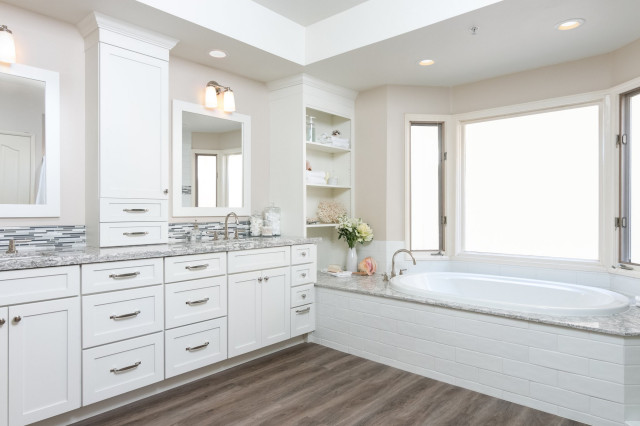

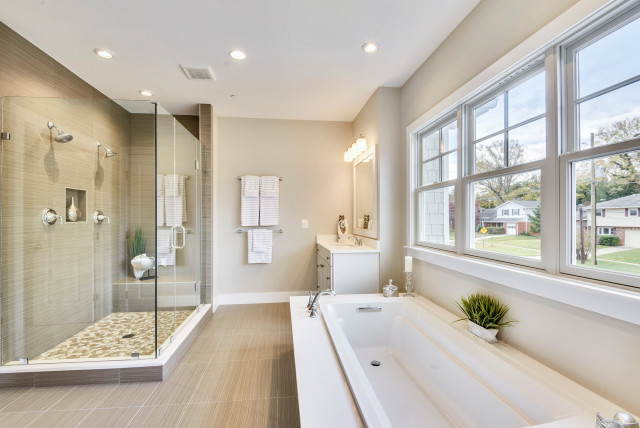

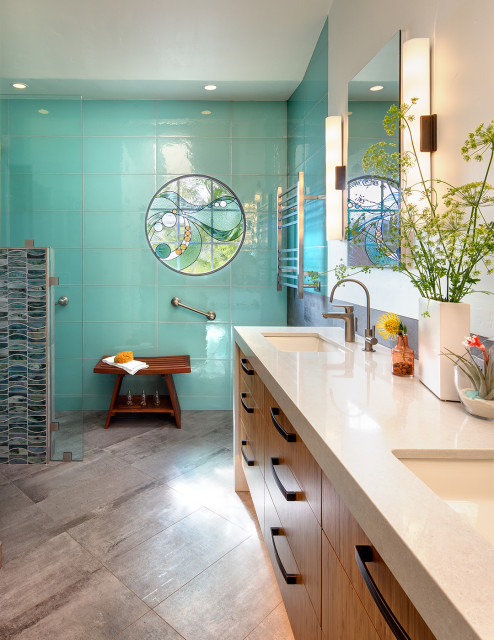









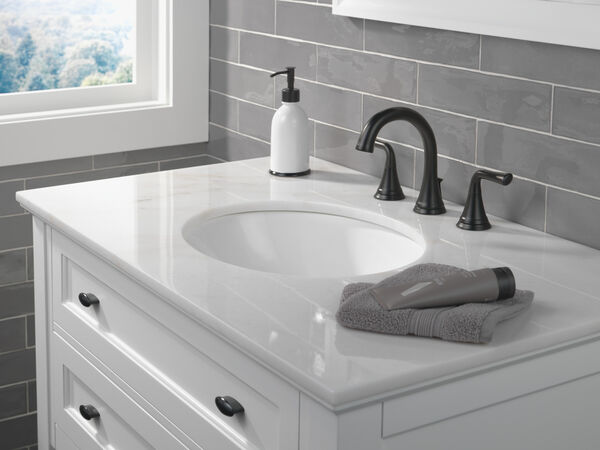
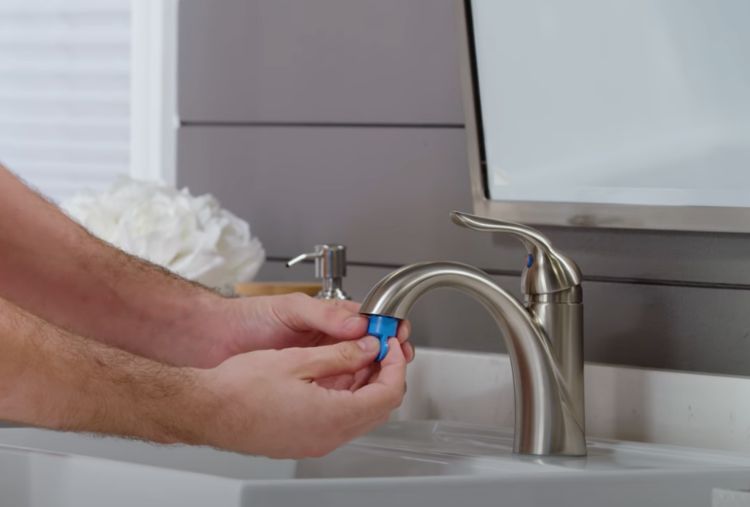
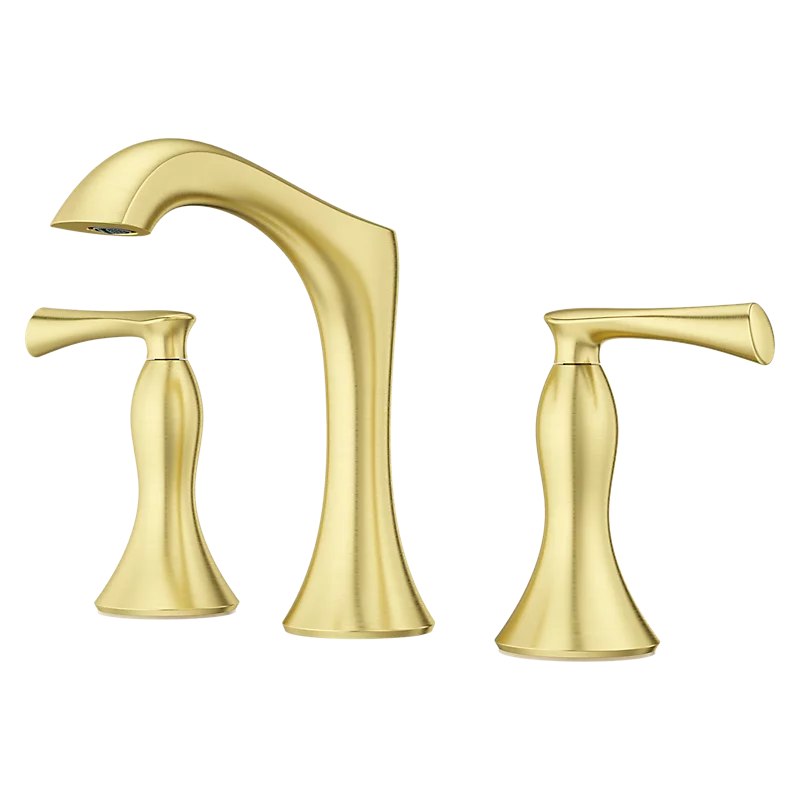
1. Go With a Low-Curb or Curbless Shower
If you’re designing or renovating a bathroom and are concerned about slips and falls, go for a low-curb or curbless shower entrance. “I feel that the vast majority of slips and falls happen when stepping over something, like a curb or a bathtub wall, and onto a surface that has potential to be slippery when wet,” design-build pro Doug Selby of Meadowlark Design + Build says.
In this San Diego bathroom, interior designer Jensen Landers of Marrokal Design & Remodeling incorporated a nearly curbless wet zone with minimal obstructions that encourages free movement. “Curbless showers are one of the best features for not slipping, as it’s easier to walk normally into a shower instead of stepping over a curb,” Landers says.